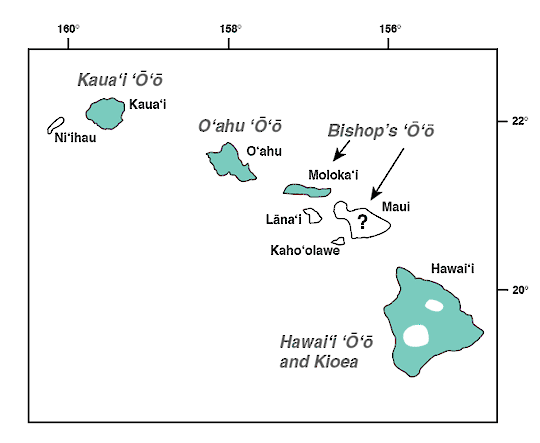Creature
Fast Facts
Introducing you to extinct species.

THE
O'AHU 'O'O
1. The Oʻahu ʻōʻō, Moho apicalis, was one of five species that belonged to the Mohoidae family group, also known as the 'Hawaiian honeyeaters'. 2. It is the only complete avian (bird) family group to go extinct in modern times, with the last one, the Kauai O’o, last being heard April 29, 1987. 3. The male Oʻahu ʻōʻō was 12 inches in length & had a beak that was 1.5 inches long. The female was smaller. 4. The male had a black body and tail feathers with white tips. The most distinguishing trait was the deep yellow sides of the body and on the sides of the wings. 5. They preferred the mountainous habitat of O'ahu in Hawaii. 6. Andrew Bloxam collected the first specimen in 1825, but the Oʻahu ʻōʻō was already rare which is why, in his own words, "the natives asked a high price for the very few they brought to me." 7. In 1837, while visiting Honolulu, Hawaii German naturalist Ferdinand Deppe found several specimens in the hills there. This was the last confirmed report. 8. In 1860, John Gould got credit for describing & naming the O‘ahu ‘ō‘ō, which had been extinct for 23 years at that time. 9. There are seven specimens in museum collections in Berlin, London, New York City & Cambridge, Massachusetts. 10. Hawaii is called the 'Bird Extinction Capital of the World' because 95 of its 142 bird species have gone extinct since the arrival of people, 11 are likely extinct, and all the remaining bird species are listed as endangered. 11. Avian malaria, a disease spread by mosquitoes accidentally brought to the Hawaiian islands by European explorers, was the leading cause of most bird extinctions.
Extinction
Cometh
Facing the light at the end of the tunnel
EXTINCTION DATE
1937
Polynesians first arrived in the Hawaiian Islands around 400 A.D. They did have an effect on the native wildlife. They cleared forests to make their farms and villages. The animals they brought with them, such as mongooses, dogs, rats, and chickens, took an even greater toll of native birds because many birds nested on the ground and had no fear of predators. In fact, Hawaii only had one mammal, the Hawaiian hoary bat. The first Hawaiians did hunt the colorful birds to create elaborate feather cloaks and hats that showed a chief's status. Native Hawaiians would capture colorful birds, pluck the needed feathers and release the birds. On January 18, 1778 Captain Cook became the first European to set foot in Hawaii. The biggest effects on the native birds started in 1826, when American whalers started dumping bilge water from their ships, thus bringing mosquitos to the Hawaiian Islands. 35 additional species went extinct after the arrival of whalers. The Americans also introduced guns to Hawaiians, and the pluck and release system of bird hunting was replaced by hunts that would kill up to 1,000 birds. The Oʻahu ʻōʻō was first described by Andrew Bloxam in 1835 and was considered rare. It was last described near Honolulu in 1837 by German naturalist, Ferdinand Deppe. John Gould scientifically named and described the O‘ahu ‘ō‘ō in 1860, 23 years after it was probably extinct. Could the Oʻahu ʻōʻō live on the Hawaiian Islands today? Although Jurassic Park is fiction, scientists are working on several de-extinction projects. In fact, in 2003 scientists did bring back the extinct Pyrenean ibex, a type of wild goat, for 7 minutes before it died, showing de-extinction is possible. The Oʻahu ʻōʻō could be a candidate. Scientists would use one of the seven museum specimens to get DNA to try to bring them back to life. Many efforts have been made in Hawaii since the Oʻahu ʻōʻō's extinction. There have been efforts to eradicate rats and invasive species from the environment. Scientists have also been working to control avian diseases and thwart the avian malaria that has affected so many species in Hawaii. If the Oʻahu ʻōʻō was brought back from extinction, could it survive in its native homeland of Hawaii?
COMING SOON
The Oʻahu ʻōʻō's Lazarus tale has yet to be written, but what adventures will await it when it returns to the islands of Hawaii? Stay tuned to find out.
More to Explore
All answers lead to more questions

Painting of the Oʻahu ʻōʻō
Image from Wikipedia
VIDEOS & ADDITIONAL INFO
Biogeography of Hawaii - Atlas Pro Video


Specimen of the Oʻahu ʻōʻō
Image Dibird.com
Specimen from Bishop Museum in Honolulu, Hawaii
Image from BirdFinding.info

Painting of the Oʻahu ʻōʻō
Image from Planet of Birds

Oʻahu ʻōʻō range map
Image from Birds of the World

Endangered Hawaiian birds
Image from Birdorable Planet

'I'iwi
Image from State of the Birds

‘Alae ‘Ula
Image from ABC Birds

Endangered Hawaiian birds
Image from Pinterest

Hawaiian State Department of Health
Image from Health.Hawaii.gov

‘Aha ‘ula (Hawaiian feather cape)
Image from Wikipedia

People brought avian diseases & malaria to Hawaii
Image from Health.Hawaii.gov



